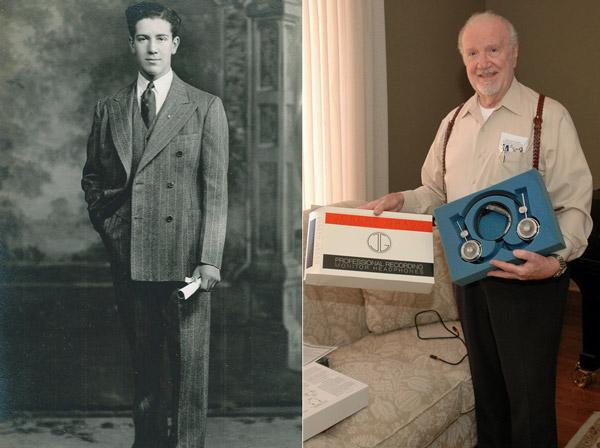Articles from CNET and Stereophile:
http://www.cnet.com/news/grado-a-pioneering-audio-designer-passes-away-at-90/
Pioneering audio designer Joseph Grado passes away
The Audiophiliac looks back on the long and distinguished career of this New York-based maker of speakers, turntables, headphones and more.
- by Steve Guttenberg
@AudiophiliacMan
- February 7, 2015 12:56 PM PST
- comments
8
- facebook
152
- twitter
161
- linkedin
2
- googleplus
- more
more +
-
Joseph Grado with one of his early headphones.Martin McKenzie
Joseph Grado, an innovative audio designer, died Friday. He was 90 years old. I met Mr. Grado only once, and that was 30 years ago when he gave a talk at the New School in New York City. He was there to discuss how he started designing phono cartridges. Before that he was a master watch builder for
Tiffany & Co. Listening to him talk, I was moved by his passion for tinkering, designing and building things; he was the classic American inventor type.
Grado Laboratories is still located in a small four-story building in the Sunset Park neighborhood in Brooklyn, NY, where Joe Grado started making phono cartridges in 1953. He invented the stereo moving-coil cartridge, and in the early years the company produced speakers, turntables and a highly acclaimed wooden tonearm. John Grado (Joe's nephew) took over day-to-day operations in the late 1970s and he bought the company in 1990, when the plant was producing 10,000 cartridges a week! The company still hand-builds all of its full-size
headphones and phono cartridges in that building.
I bought my first Grado cartridge for around $10 in the early 1970s, and it blew away all of the Empire, Pickering, Shure, and Stanton cartridges I had used up to that point, not because the little gray plastic Grado cartridge sounded more accurate or detailed, but because it was more fun to listen to. My Rolling Stones and Led Zeppelin LPs rocked harder with the Grado tracing the grooves; it really was as simple as that.
MORE GRADO
- A visit to Grado's Brooklyn headphone factory
- Grado SR325e headphone review
In the early 1990s Joseph Grado started designing high-end headphones, and the three initial models -- the HP-1, HP-2 and HP-3 -- were hugely popular with recording engineers and audiophiles. They were all hand-built by Joseph and John Grado, and those headphones now fetch many times their original prices on eBay.
In recent years Grado designed a
professional microphonethat drew raves from admiring engineers. Joseph Grado also loved singing and painting, and he held the rights to 48 patents.
http://www.stereophile.com/content/joe-grado-1925%C2%961915
oe Grado (1925–2015)
By Herb Reichert • Posted: Feb 7, 2015
Hats off and heads down. Let Joe Grado's passing fill our collective hearts with enduring feelings of gratitude (for what Joe brought to the quality and character of the audio industry over six decades) and respect (for his myriad inventions and human fortitude that delivered musical joy and aural insights to countless listeners and audio professionals throughout the world). Joe Grado was a mechanic, an engineer, an inventor (with scores of patents), an inveterate tinkerer, an artist, an operatic tenor, and an old-school American entrepreneur. Joe Grado and Saul Marantz can legitimately be called the Ben Franklin and George Washington of high-end American audio. Famously, Mr. Franklin invented bifocal glasses and demonstrated the true nature of electricity. Also famously, Joe Grado invented the stereophonic moving-coil cartridge and put countless people in touch with the real pleasures of listening to music with high-quality headphones.
Saul Marantz (aka George Washington) helped Joe Grado get his first job in audio, but very quickly the young Grado set out on his own. Joe founded Grado Labs in 1953. In 1955, he moved the operation into the storefront that was once his father's grocery store.
Joe Grado's Sicilian-born father was the kind of immigrant hero my father always proselytized about. My dad said European immigrants dreamed of coming to America, starting a business, working hard, and eventually, ending up with a modest building with their family name on the facade. Well, that is exactly what the Grado clan did. Except! 60 years later, Grado Labs is still in the same modest Brooklyn building (below) but out front, there has never been a 'Grado' sign of any kind—only just graffiti!
Joe and his wife started out building cartridges by hand on the kitchen table. Then Joe and his nephew John (who joined the company in 1965 and bought the company in 1990 when Joe retired) continued to build cartridges by hand. In 1977, Joe and John and their modest team of craftspeople were hand making 10,000 cartridges per week!
IIt should be noted that after building moving-coil cartridges during the early 1950s, Joe didn't chose to ride that invention for fame or profit. Instead, he rejected that technology and built his brand and reputation on the virtues and musicality of higher-output moving-iron designs.
While building his iconic business, Joe never lost touch with his love of art and his identity as an artist. He made paintings and, in May of 1981, Joe Grado made his debut as a dramatic tenor performing a program of all-Italian songs at Lincoln Center's Alice Tully Hall. Bravo Joe! Bravo!
Grado Labs started hand-making headphones in 1989. Over the course of the 1990s Grado headphones developed a reputation as natural-sounding, fun-loving, "rock-and-roll" headphones to be enjoyed, not just as professional recording tools or as "shush, the kids are asleep!" compromises—but as a full-satisfaction alternative to conventional loudspeakers. This was huge, and a major contribution to the powerful emergence of headphones in the youth and high-end audio markets of today.
I have bought countless Grado cartridges. And always used Grado headphones. Their originalHP-1 "Professional Recording Monitor" 'phones were beyond beautiful, extremely expensive (at $595 in 1991) and today fetch as much on eBay as the most exotic new high-end models. It is impossible to say exactly how big Joe Grado’s influence was on the history of audio, but to me, he was a venerable giant.
Of course Joe's passing makes me sad—but even more, it makes me grateful for all the joy and inspiration his work and invention has given me.
Speaking for everyone at Stereophile, I offer our respectful and heartfelt condolences to the entire Grado family as well as the dedicated league of Grado workers, craft persons and family friends. Joe Grado was unquestionably of one audio's founding fathers and his passing marks the end of a glorious era. Thank you Joe—you shall not be forgotten.
The photo on the left was taken by Martin in Joe's living room holding his HP1000.







